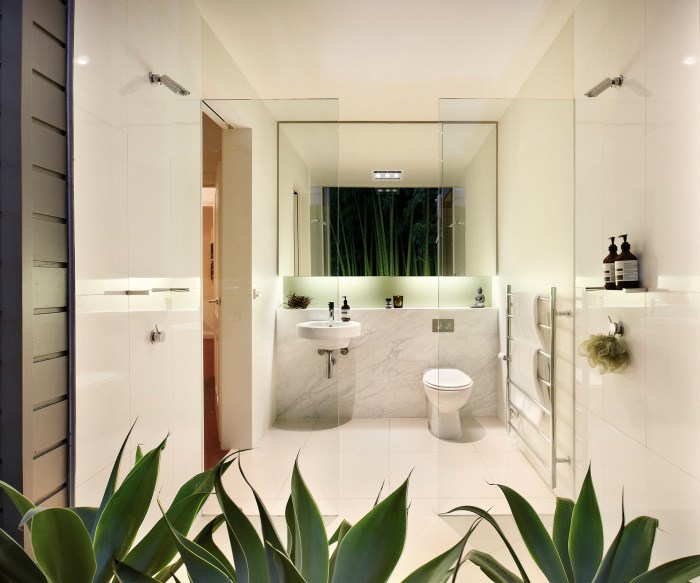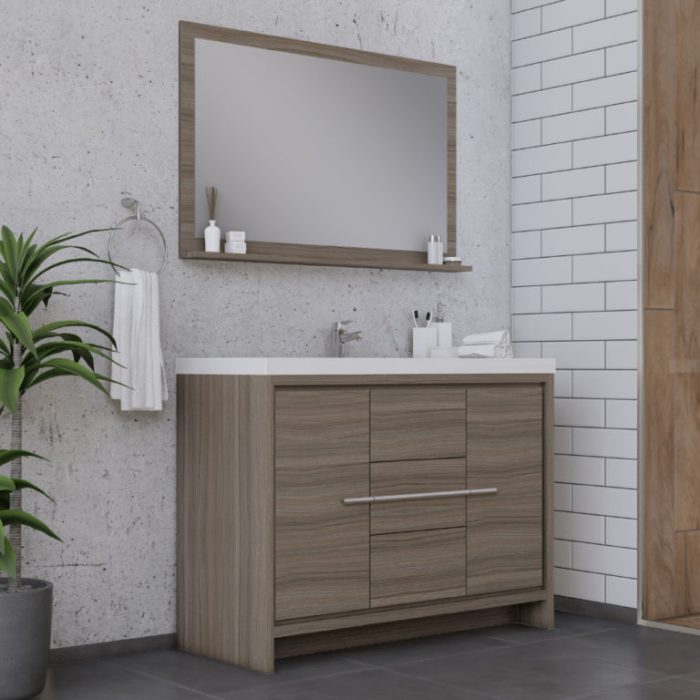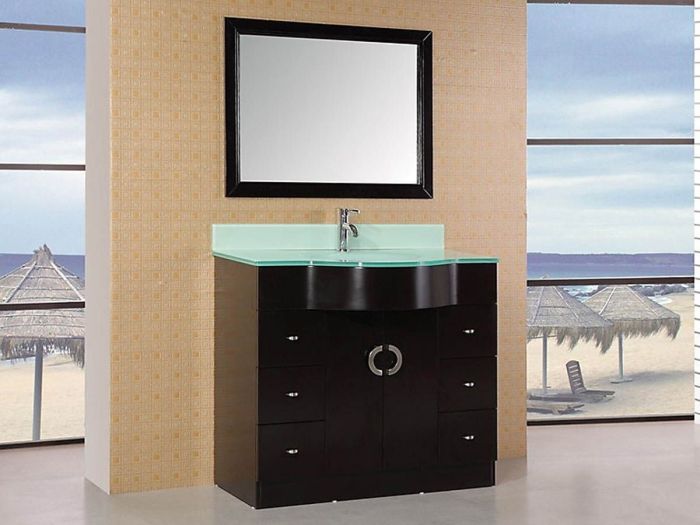In today’s environmentally conscious era, sustainable living has become a priority. As we strive to reduce our ecological footprint, it’s time to extend this ethos to our homes, including our bathrooms. Eco-friendly bathroom furniture and vanities offer a harmonious blend of style and sustainability, catering to both our aesthetic preferences and our planet’s well-being.
From water-saving features to durable construction and non-toxic materials, eco-friendly bathroom furniture goes beyond aesthetics. It’s an investment in a healthier home environment and a more sustainable future.
Eco-friendly Materials
Eco-friendly bathroom furniture and vanities utilize sustainable materials that minimize environmental impact. These materials often come from renewable sources, are biodegradable, and have low embodied energy.
Benefits of eco-friendly materials include:
- Reduced deforestation and habitat loss
- Lower greenhouse gas emissions
- Conservation of natural resources
- Improved indoor air quality
Types of Eco-friendly Materials
Common eco-friendly materials used in bathroom furniture and vanities include:
- Bamboo: A rapidly renewable grass with a high strength-to-weight ratio, making it suitable for vanities and countertops.
- Cork: A natural insulator harvested from the bark of cork oak trees, used for flooring, wall coverings, and drawer liners.
- Recycled wood: Reclaimed wood from old buildings or furniture, reducing waste and conserving forests.
- Low-VOC finishes: Finishes with low levels of volatile organic compounds (VOCs), reducing indoor air pollution.
- Plant-based plastics: Biodegradable plastics made from renewable resources like corn or sugarcane, used for drawer handles or shower curtains.
Water Conservation
Eco-friendly bathroom furniture and vanities incorporate various water-saving features to reduce water consumption and promote sustainability. These features include low-flow faucets, aerators, and dual-flush toilets.Low-flow faucets limit the amount of water released per minute, significantly reducing water usage. Aerators, attached to faucets, introduce air into the water stream, creating a fuller flow while using less water.
Dual-flush toilets provide two flushing options: a full flush for solid waste and a half flush for liquid waste, conserving water in situations where a full flush is unnecessary.These features contribute to reducing water consumption by restricting the flow rate and providing efficient flushing mechanisms.
By incorporating these features, eco-friendly bathroom furniture and vanities play a crucial role in promoting water conservation efforts and reducing the environmental impact of bathroom fixtures.
Low-Flow Faucets
Low-flow faucets are designed to limit the flow rate of water, typically to a maximum of 1.5 gallons per minute (GPM) or less. This is significantly lower than the flow rate of conventional faucets, which can range from 2.2 to 3.5 GPM.By
reducing the flow rate, low-flow faucets can save a substantial amount of water over time. For example, a faucet with a flow rate of 1.5 GPM can save up to 1,500 gallons of water per year compared to a conventional faucet with a flow rate of 3.5 GPM.
Aerators
Aerators are small devices that attach to the end of faucets and introduce air into the water stream. This creates a fuller flow of water while using less water overall.Aerators work by mixing air with water, creating a larger volume of water that feels more substantial when it flows out of the faucet.
This allows users to reduce the flow rate of water without sacrificing the perceived volume of water, resulting in water savings.
Dual-Flush Toilets
Dual-flush toilets provide two flushing options: a full flush for solid waste and a half flush for liquid waste. This allows users to conserve water in situations where a full flush is unnecessary, such as when only liquid waste is being flushed.Full
flushes typically use around 1.6 gallons of water, while half flushes use around 0.8 gallons of water. By providing the option of a half flush, dual-flush toilets can save a significant amount of water over time. For example, a family of four can save up to 20,000 gallons of water per year by using a dual-flush toilet instead of a conventional toilet.
Energy Efficiency
Eco-friendly bathroom furniture and vanities prioritize energy efficiency to reduce energy consumption and environmental impact. These products incorporate various elements that contribute to energy conservation.
Energy-efficient lighting is a key aspect. LED bulbs consume significantly less energy than traditional incandescent or fluorescent bulbs, reducing electricity usage and lowering energy bills. They also have longer lifespans, minimizing the need for frequent replacements.
Energy-Saving Appliances
Energy-saving appliances, such as low-flow faucets and toilets, conserve water and reduce energy consumption. Low-flow faucets restrict water flow, reducing the amount of energy required to heat water. Dual-flush toilets offer two flushing options, allowing users to choose a lower water volume for liquid waste, conserving water and energy.
Motion-Activated Features
Motion-activated features enhance energy efficiency by automatically controlling lighting and ventilation. Motion sensors detect movement and turn on lights or exhaust fans only when necessary, reducing energy waste when the bathroom is unoccupied.
Smart Home Integration
Smart home integration allows users to control bathroom functions remotely. Smart thermostats and lighting systems can be programmed to optimize energy usage based on schedules or occupancy. This eliminates energy waste due to forgotten appliances or lights left on.
Durability and Longevity
Eco-friendly bathroom furniture and vanities are designed to withstand the demands of daily use while maintaining their aesthetic appeal. The use of sustainable materials, such as bamboo, cork, and reclaimed wood, contributes to their long-lasting nature. These materials are naturally resistant to moisture, warping, and fading, ensuring that your bathroom furniture will remain in pristine condition for years to come.
Design Features for Enhanced Durability
Apart from the inherent durability of sustainable materials, eco-friendly bathroom furniture and vanities often incorporate design features that further enhance their longevity. These features include:
- Solid wood construction: Solid wood frames provide exceptional strength and stability, ensuring that your furniture can withstand heavy use and accidental bumps.
- Stainless steel hardware: Stainless steel hinges, drawer slides, and handles are resistant to corrosion and rust, ensuring smooth operation and a long lifespan.
- Moisture-resistant finishes: Eco-friendly finishes, such as low-VOC paints and sealants, protect the furniture from moisture damage, preventing warping and discoloration.
Health and Safety
Eco-friendly bathroom furniture and vanities prioritize the health and well-being of users. By utilizing sustainable materials and manufacturing processes, they eliminate the presence of harmful chemicals and emissions, contributing to a healthier indoor environment.
Absence of Harmful Chemicals
Traditional bathroom furniture and vanities may contain volatile organic compounds (VOCs), formaldehyde, and other hazardous substances that can release toxic fumes into the air. These emissions can cause respiratory problems, skin irritation, and even contribute to long-term health issues. In contrast, eco-friendly alternatives are made from materials that do not emit harmful chemicals, reducing the risk of indoor air pollution and its associated health concerns.
Improved Indoor Air Quality
By eliminating the release of harmful chemicals, eco-friendly bathroom furniture and vanities improve indoor air quality, creating a healthier and more comfortable environment. This is particularly beneficial for individuals with respiratory sensitivities or allergies, as they are less likely to experience adverse reactions or discomfort.
Impact on Human Health and Well-being
The absence of harmful chemicals in eco-friendly bathroom furniture and vanities promotes overall health and well-being. By reducing exposure to toxic substances, they contribute to a healthier respiratory system, reduced skin irritation, and an overall improved sense of well-being. In the long term, these benefits can have a positive impact on health and quality of life.
Aesthetics and Design
Eco-friendly bathroom furniture and vanities offer a wide range of styles and designs to complement any bathroom decor. From traditional to modern, rustic to contemporary, there’s an eco-friendly option to suit every taste.
Materials and Aesthetics
Eco-friendly materials, such as bamboo, recycled wood, and cork, can be used to create a variety of aesthetic effects. Bamboo, with its natural grain patterns, lends a warm and inviting feel to a bathroom. Recycled wood, with its unique patina and imperfections, adds character and a touch of history.
Cork, with its soft texture and sound-absorbing properties, creates a spa-like atmosphere.
Innovative Designs
Eco-friendly bathroom furniture and vanities are not just about sustainability; they’re also about style. Innovative designs incorporate eco-friendly materials into visually appealing pieces that enhance the functionality and beauty of any bathroom. For example, a vanity made from reclaimed wood with a live edge can serve as a stunning focal point, while a floating vanity made from bamboo can create the illusion of more space.
Maintenance and Care
Maintaining eco-friendly bathroom furniture and vanities properly is essential to prolong their lifespan and preserve their eco-friendly qualities.Regular cleaning is crucial to prevent dirt and grime buildup, which can damage the finish and reduce the effectiveness of eco-friendly features. Use mild, non-abrasive cleaners and a soft cloth to wipe down surfaces gently.
Avoid using harsh chemicals or scouring pads, as these can scratch or damage the materials.
Trends and Innovations
The eco-friendly bathroom furniture and vanity industry is constantly evolving, with new trends and innovations emerging all the time. These innovations are driven by a desire to create products that are more sustainable, water-efficient, energy-efficient, and durable.Emerging technologies and design concepts are shaping the industry, such as the use of recycled materials, smart technology, and water-saving fixtures.
Cutting-edge products and solutions include bathroom furniture made from sustainable materials like bamboo and cork, vanities with built-in water filtration systems, and smart mirrors that can track water usage and energy consumption.
Emerging Technologies
*
-*Recycled materials
Recycled materials, such as reclaimed wood and plastic, are increasingly being used in the production of eco-friendly bathroom furniture and vanities. These materials help to reduce waste and conserve natural resources.
-
-*Smart technology
Smart technology is being integrated into bathroom furniture and vanities to improve water and energy efficiency. For example, some vanities have built-in water filtration systems that remove impurities from the water, while others have smart mirrors that can track water usage and energy consumption.
-*Water-saving fixtures
Water-saving fixtures, such as low-flow toilets and faucets, are becoming increasingly common in eco-friendly bathrooms. These fixtures help to reduce water consumption and save money on utility bills.
Innovative Design Concepts
*
-*Minimalism
Minimalism is a popular design trend in eco-friendly bathrooms. Minimalist designs use simple lines and shapes to create a clean and uncluttered look. This type of design can help to reduce waste and conserve resources.
-
-*Natural materials
Natural materials, such as wood, stone, and bamboo, are often used in eco-friendly bathroom furniture and vanities. These materials are sustainable and help to create a warm and inviting atmosphere.
-*Multi-functional furniture
Multi-functional furniture is a great way to save space and reduce waste in the bathroom. For example, some vanities have built-in storage drawers or shelves, while others can be used as both a vanity and a storage cabinet.
Case Studies and Examples
Various successful projects have showcased the effective implementation of eco-friendly bathroom furniture and vanities.
These projects have demonstrated the benefits of sustainable practices, including reduced environmental impact, cost savings, and enhanced user satisfaction.
Awarded Projects
- The “Green Bathroom” project by Studio X won the “Sustainable Design Award” for its innovative use of recycled materials and energy-efficient appliances.
- The “Eco-Friendly Bathroom” project by GreenWorks received the “Environmental Excellence Award” for its comprehensive approach to sustainability, including water conservation, energy efficiency, and healthy materials.
Challenges and Benefits
Challenges faced in these projects included the availability of eco-friendly materials, the higher initial cost of sustainable products, and the need for specialized expertise in installation and maintenance.
However, the benefits outweighed the challenges, including reduced water consumption, lower energy bills, improved indoor air quality, and increased durability of the bathroom furniture and vanities.
Best Practices and Lessons Learned
- Thoroughly research eco-friendly materials and products to ensure they meet sustainability standards.
- Consider the life-cycle cost of bathroom furniture and vanities, including the environmental impact and maintenance costs.
- Collaborate with experienced professionals for proper installation and maintenance of eco-friendly bathroom furniture and vanities.
Closure
Embracing eco-friendly bathroom furniture and vanities is not just a trend; it’s a responsible choice. By opting for sustainable materials, energy-efficient designs, and durable construction, we can create beautiful and functional bathrooms that align with our values and contribute to a greener planet.
Let’s make conscious choices today for a more sustainable tomorrow.



